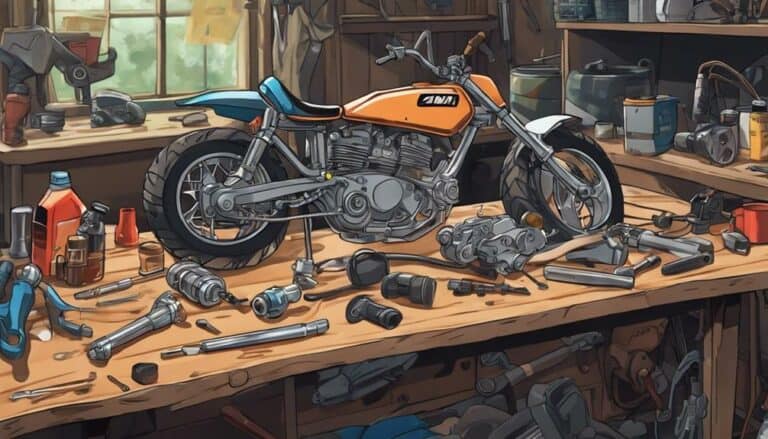To adjust the dirt bike carburetor effectively, start by seeking out the specific screws that control the fuel and air mixture. Once you locate these important components, the process becomes more manageable.
However, remember that adjusting the carburetor is only one piece of the puzzle; ensuring the overall performance of your dirt bike requires attention to other maintenance areas as well.
By grasping the intricate workings of the carburetor, you set the stage for improved engine efficiency and a smoother ride.
Key Takeaways
- Use tools like screwdrivers and wrenches for precise carburetor adjustments.
- Locate the carburetor near the engine intake manifold for tuning.
- Adjust idle speed carefully for smooth idling and responsiveness.
- Fine-tune air-fuel mixture for optimal performance and throttle response.
Tools Required for Carburetor Adjustment
To properly adjust a dirt bike carburetor, you'll need basic tools such as screwdrivers, wrenches, and pliers, along with potentially specialized tools like jetting kits or carburetor synchronizers. These tools are essential for fine-tuning your dirt bike's carburetor to guarantee peak performance. When working on your carburetor, having the right tools at your disposal is critical for making precise adjustments that can greatly impact your bike's power delivery and efficiency.
Basic tools like screwdrivers are necessary for adjusting the idle speed and air-fuel mixture screws, while wrenches come in handy for removing and reinstalling the carburetor. Pliers are useful for adjusting throttle cables and choke mechanisms. Specialized tools like jetting kits allow you to change the size of the jets inside the carburetor to accommodate different riding conditions. Carburetor synchronizers help ensure that all cylinders receive an equal amount of fuel-air mixture for balanced performance. Having these tools ready and knowing how to use them will empower you to fine-tune your dirt bike's carburetor effectively.
Locating the Carburetor on Your Dirt Bike
The carburetor on your dirt bike is typically situated near the engine intake manifold. Here are some steps to help you locate it:
- Near the Engine Intake Manifold: The carburetor is usually found close to where the engine intake manifold connects to the engine block. This placement allows for better control of the air-fuel mixture entering the engine.
- Side or Top of the Engine: Look for a metal component attached to the side or top of the engine. This component is often the carburetor, responsible for mixing air and fuel before it enters the engine cylinders.
- Connected to Air Filter and Fuel Line: The carburetor is easily identifiable by its connection to the air filter and fuel line. This connection makes sure that clean air flows into the engine and that fuel is delivered in the correct proportion.
- Under Gas Tank or Airbox: In many dirt bikes, the carburetor is located under the gas tank or airbox. This positioning helps protect the carburetor while still allowing for efficient air flow.
Adjusting the Idle Speed
Adjust idle speed on your dirt bike carburetor by locating the idle screw and using a screwdriver to make precise adjustments. The idle screw is generally situated on the side or bottom of the carburetor.
To increase the idle speed, turn the idle screw clockwise; to decrease it, turn counterclockwise. Make small and gradual adjustments to prevent stalling or excessive revving.
It's important to adjust the idle speed when the bike is at operating temperature to guarantee accurate results. Proper adjustment of the idle speed is vital for smooth idling performance and responsiveness during starting and stops.
Fine-Tuning the Air-Fuel Mixture
Fine-tune your dirt bike's air-fuel mixture by adjusting the fuel screw for best idle and low throttle performance. Here are four essential steps to make sure you get it right:
- Start with the Basics: Before adjusting the fuel screw, make sure your bike is at the correct idle speed. Use a tachometer to set the idle speed according to the manufacturer's specifications.
- Clockwise vs. Counterclockwise: Turning the fuel screw clockwise will weaken the mixture, while counterclockwise adjustments will enrich it. Fine-tune the screw gradually to find the sweet spot for optimal performance.
- Listen and Feel: As you adjust the fuel screw, pay attention to how the engine responds. You should aim for smooth idling and crisp throttle response. Small adjustments can make a significant difference.
- Test and Refine: After adjusting the air-fuel mixture, take your dirt bike for a test ride. Pay attention to how it accelerates, idles, and responds to throttle inputs. Make further adjustments if needed to achieve the perfect balance.
Testing Your Dirt Bike After Adjustment
After adjusting your dirt bike carburetor, how can you effectively evaluate its performance to guarantee peak functioning?
Once the adjustments are made, you're going to start the engine and allow it to warm up to its operating temperature. Listen for any unusual sounds, stalls, or rough idling that could signal the need for further tuning.
When you rev the engine in neutral, pay attention to the throttle response and make sure the RPM levels are consistent.
Next, take your dirt bike for a test ride to assess acceleration, smooth power delivery, and overall performance. During the ride, monitor the fuel consumption and the color of the exhaust smoke to confirm that the air-fuel mixture adjustments are correct.
Conclusion
Now that you have successfully adjusted your dirt bike carburetor, take it for a test ride to feel the improved performance firsthand.
The precision you put into tuning the main and pilot jets, along with fine-tuning the air-fuel mixture, will guarantee peak engine response and power delivery.
Experience the thrill of a well-tuned machine as you hit the trails with confidence and precision.
Your attention to detail has paid off in a smoother and more responsive ride.

